The Wild Mangos of Borneo
Richard J. Campbell, Ph.D., Senior Curator of Tropical Fruit
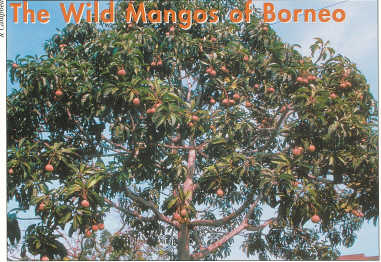
Mangifera pajang in fruit in Borneo
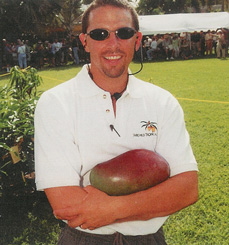
Richard J. Cambell with a fine ‘Lancetilla’ fruit
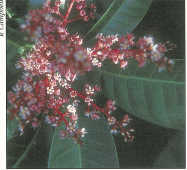
Mangifera odorata blossom
“We drove along the rocky north coast of Sarawak in search of the mangga aer (Mangifera laurina), kuini (Mangifera odorata), bembangan (Mangifera pajang) and bachang (Mangifera foetida). These wild mangos dominate both remnant forests and home gardens, casting their shade upon the South China Sea. From a distance, these Goliath beings have a spectacular appearance. I will never forget the way they jut out of the rocky soil within sight of the sea, forming picturesque lollipops, ablaze with red, white or purple flower spikes-the result of a three-week dry spell preceding our arrival. At first we found it difficult to distinguish among the various species, but after visiting home gardens in the area, we learned how to locate and identify distinct species and were able to gather bud-wood. As usual, the local people were curious and amused by our appear ance and activities. They were happy to provide us with pieces of their trees. ” (excerpt from Borneo Expedition Report, September, 2001)
Wild mangos were brought to the attention of the scientific community a decade ago in The Mangos: Their Botany, Nomenclature, Horticulture and Utilization, a book written by botanists A. J. G. H. Kostermans and J. M. Bompard. The wild mangos they described are purportedly gold mines of genetic potential for the modern mango industry, which is based solely on the species Mangifera indica. From salt tolerance to disease resistance, these wild mangos could hold the genetic key to the mango's future. Unfortunately, because of our ignorance of the horticultural traits of these lesser-known species, there is a huge gulf between potential and actual use.

Graft of Mangifera pajang on M. indica
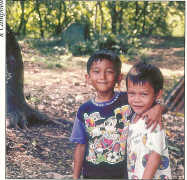
Proud guardians of the wild mangos of Borneo.
We set out to enhance the Mangifera genetic collections at Fairchild Tropical Botanic Garden by the addition of wild mangos, and to investigate, in some small way, their potential. Once we had our scions of wild mangos, we had to determine their graft compatibility with the Mangifera indica rootstocks available in Florida. Graft compatibility is crucial to success because the wild mangos are not well adapted to our soils. Further, we are interested in superior selections — ones that will allow for precocious fruiting and a top quality product. Seedlings require years to reach bearing age, with no guarantee of quality.
Our initial efforts met with some notable failures, but also provided some modest successes. We identified, collected and grafted superior clones of 12 Mangifera species, and have now established Mangifera casturi, M.foetida, M. griffithii, M. laurina, M. odorata, M. pajang, and M. pentandra on 'Turpentine' rootstocks (M. indica). Among these wild mangos may be genes for mangos with new spice flavors, mangos ideal for use green, mangos well-flavored for chutneys and pickles, and mangos ideal for fresh fruit for tropical America. Further, we hope to create hybrids with greater resistance to pests, diseases and environmental stresses.
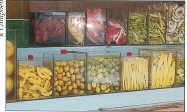
Kuching preserved fruit
Yet, I still found myself concerned as to their value. For all we knew, the superior genes contained within these species had already found their way off Borneo and into modern mangos. However, in early September of 2001, in the heat and humidity of northern Borneo, their potential became abundantly clear as we observed their profuse bloom, and heavy crops of developing and ripe fruit — all surprisingly free of disease. Almost all cultivars of M. indica would fail miserably under these same conditions. Herein lies their potential, not only for Borneo, but also for the humid tropical regions all over the world.
The challenge ahead is to grow these trees successfully, characterize them genetically and begin to determine their potential. In the far distant future is the hope for hybridization with the commercial mango, a union that could yield superior disease resistance, and adaptability to sub-optimal conditions. Meanwhile we continue to study and display to the public, the newest addition to the world of the mango at Fairchild Tropical Botanic Garden — the wild mangos of Borneo.